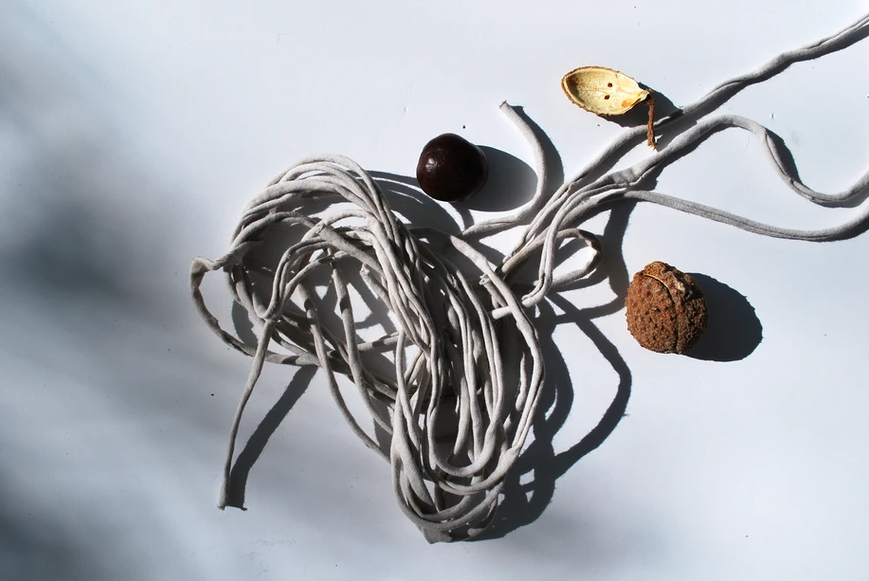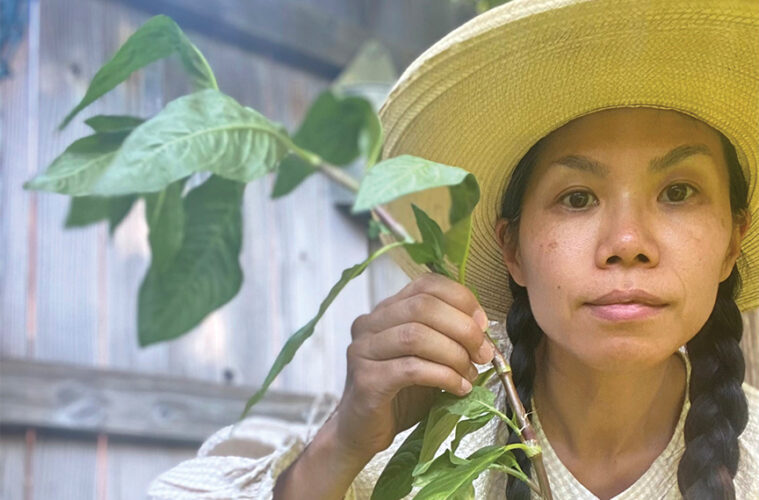Maki is a botanical dye fiber artist, Steele mom and Wash Park neighbor. We were grateful for the opportunity to learn more about her art and dedication to sustainability.
Maki, you are originally from Japan. How did you find yourself in Denver?
Denver reminds me of my home in Kyoto, Japan, you can see mountains wherever you look. I was born and raised in Japan and worked as a socks pattern designer in Osaka after graduating college. I met my husband when he was studying abroad in Japan. After working for a couple years, we came to the US together. We lived in Washington DC and then lived in New York City for 15 years where I worked as a textile surface designer for various fashion companies.
We moved to Denver in early 2021. The pandemic changed our perspective and I was heartbroken by reckless Asian hate crimes happening in this country. When we visited Denver, the turquoise blue sky and mountains healed me. We decided to move here right away. We love living in a spacious house, have two cute dogs, Sosuke and Ponyo. Our daughters are very happy to be in Denver.
 You are a botanical dye fiber artist, among other many talents. What can you tell us about this craft, and what does the harvesting process for your colors entail?
You are a botanical dye fiber artist, among other many talents. What can you tell us about this craft, and what does the harvesting process for your colors entail?
My artistic medium involves working with natural materials to capture the fleeting beauty of nature in a long-lasting form. The most beautiful colors in nature are often fragile and can only exist under specific conditions. But, through my techniques, I’m able to enrich and refine their colors, allowing them to survive and thrive on fibers.
It is actually normal to have colors that fade over time – because they are natural. We’ve all become used to having synthetic artificial colors that are bright, deep, and almost permanent. But those colors aren’t sustainable.
I use many natural materials such as food wastes, spices, and exotic plants from all over the world. When I was in New York, I went to super markets to get materials such as areca nuts from Indian grocery stores, seaweed from Japanese stores, and food waste like avocado pits from restaurants. Since I moved to Denver, I started to learn about gardening. I’ve started to grow indigo, marigold and camomile in my backyard. It is a joy to experience the whole life cycle of plants from seeding, growing, and harvesting for use for creating colors.
What can you tell us about your Tomorrow is Always New Studio?
“Yesterday and today are similar but they are not the same. And tomorrow is always new.”
– Time, by Shuntaro Tanigawa
Shuntaro’s poem captures the concept of time for children. Everyday passes by so quickly and everyday seems the same, but actually everyday is new. I know the name of the studio is very long, but I could not come up with anything shorter! I focus on creating artworks, and experimenting with new materials. Right now, my “studio” is in the basement and attic in our house. I’m planning to renovate our garage to make it into a gallery/studio space. Hopefully I can invite people to do dyeing workshops soon. So stay tuned.
You’re currently working on a large-scale knot installation on the fence along Alameda Ave between Marion Parkway and Lafayette Avenue. We’re so excited about this project! Can you tell us what inspired you?
Thank you – I’m excited too! This project is called Musubi, which literally means “tying” in Japanese. Each participant will put their individual wish into their knot called Kanou Musubi (which means a wishing knot) as they tie it in a collective experience. Musubi’s figurative meaning is the act of connection. The goal of this project is to create a participatory, collective artwork that expands and evolves over time as more people interact with it and add their wishes.
The natural dyeing element of this work offers a sense of connection to nature. The section of Alameda Avenue at Marion Parkway sees nearly 35,000 cars daily and many pedestrians. This installation will be a visible reminder of our connectedness to each other, adding a calming, healing effect open to all passing by. To create the project I upcycled hundreds of used t-shirts and hand-dyed them using all natural materials, cutting them into strips to make cords. The textiles will be influenced by the environment as the knots age and change colors. This project is also my personal re-connection to my own Japanese culture. I also want to thank my project partner Theresa Nuber for her tremendous contribution.
We will have Knot Making Workshops at Steele Elementary School, Denver Botanic Gardens and Redline Gallery in April and May. Please check the dates on my website (www.tomorrowisalwaysnew.com). I hope you can participate to connect!
You handcraft so many unique and beautiful textiles. Where can we find them?
I will have a show called KoiNobori: Swimming Upstream in collaboration with Stitched Access works at Access Gallery in April. I had such a wonderful time being an artist-in-residence at Access Gallery last year. They are a non-profit organization, which opens doors to creative, educational and economic opportunities for people with disabilities. We dyed fabrics naturally every week for two months. For this exhibition, we transformed the fabrics into Koi Fish to create a meditative mobile. I will be at the gallery on Friday, April 21st to talk more about the show. I also slowly started to get to know the Japanese community in Denver. I collaborated with two ramen shop owners. Ramen Star in Highlands and Miyako Ramen to create naturally dyed linen Noren curtains. Please visit them to slurp authentic ramen noodles and enjoy my art.
We love the sustainability element of your art. Does this practice bleed beyond your art and into your everyday life?
All of the materials I use for my dyeing practice, are compostable. I try to use biodegradable, natural fibers, so that they all go back to the earth. I also try to use recycled materials as much as possible to create artworks. Dyeing requires so much water, so I started to collect rain/snow water. I have a love and hate relationship with fashion, but I must admit I am obsessed with clothes. I love using The RealReal and consignment stores to purchase secondhand. I try to wear my clothes for a long period of time, so I mend and over-dye. I’m also obsessed with vintage baskets, tools, textiles, and furniture. There is SO MUCH STUFF already well-made in this world. We don’t have to buy brand new things! Besides, it’s so much fun to hunt for treasure at Goodwill & vintage stores!
Do you teach workshops on the natural dyeing process?
YouTube has so many amazing free lessons. I recommend getting one natural dyeing book to start with. Then, see what you discover. Natural dyeing is just like cooking or baking. There are many ways to create natural colors. My process combines Japanese and Western techniques. I hope you can discover your own recipes.
I’ve been fortunate to teach at various organizations in Denver such as the Denver Art Museum, and Denver Botanic Gardens. I love doing workshops at unexpected places as well. I did a marigold dyeing workshop at the new flower shop, Kara Kara Blooms. It’s always special to meet people who are creative and curious about natural colors. Once my studio is set up, I would love to invite people to take my workshops. I am looking forward to meeting you soon.
Maki, thank you so much for opening our eyes to the beautiful ways of connecting with our neighbors and our natural environment. To learn more, visit www.tomorrowisalwaysnew.com.

